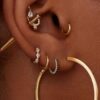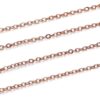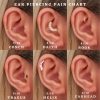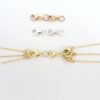Nose Piercing
Rejected Septum Piercing: Signs, Prevention, and How to Stop It
Over the years, I’ve adorned my body with a variety of piercings, each holding a memory and a story of its own. From the first nervous prick of the needle to the pride of showing off a new shimmering accessory, I’ve experienced it all. But like many others, I’ve had my fair share of complications. And trust me, it’s not all about how cool they look. Understanding the possible complications of a piercing is crucial. It can save you a lot of pain, time, and yes, even heartbreak (I’m looking at you, my favorite belly button ring that I had to take out!).
Contents
- 1 What is Septum Piercing Rejection?
- 2 Signs of a Rejecting Septum Piercing
- 3 What causes your body to reject a septum piercing?
- 4 1. Material of Jewelry
- 5 2. Piercing Technique
- 6 3. Physical Trauma
- 7 4. Inadequate Aftercare
- 8 How to Treat Septum Piercing Rejection?
- 9 Consideration for Repiercing
- 10 Preventative Measures for Future Piercings
- 11 Choosing the Right Jewelry
- 12 Proper Aftercare
- 13 Personal Experience & Recommendations
- 14 How do I know if my septum piercing is rejecting?
- 15 Why do septum piercings reject?
- 16 Expert Tips and Tricks
- 17 FAQs
- 18 Conclusion
What is Septum Piercing Rejection?
Septum piercing rejection occurs when the body’s immune system identifies the jewelry inserted through the septum—the tissue separating the nostrils—as a foreign object and initiates a response to push it out. It is the body’s natural defense mechanism against potential threats. During this process, the piercing may move or migrate, eventually becoming more superficial. If not addressed, this can result in the jewelry being fully expelled, leaving behind scars or other complications. Septum piercing rejection is different from an infection, though similar symptoms like redness, swelling, and discomfort may be present.
Why Septum Piercings?
Septum piercings, often seen adorned by celebrities and influencers alike, have become a rage in the past decade. Their popularity isn’t just because of the edgy aesthetic appeal they offer, but also the cultural and historical significance they hold in many societies. However, like all good things, they come with their own set of challenges. Risks associated with septum piercings are unique, and while they might be the fashion statement of the decade, they also require a higher degree of care.
Signs of a Rejecting Septum Piercing
Visible Movement
One of the earliest and most apparent signs of a rejecting septum piercing is its movement. Now, I’m not talking about the day-to-day shifts you might notice, but the gradual, slow “migration” of the piercing. If you start to see more and more of the barbell or if the piercing seems to be ‘traveling’, it might be time to consult with a professional.
Increased Redness and Pain
Remember the subtle throbbing after you first got your piercing? That’s normal. However, if after the initial healing phase, you start to notice a persistent redness and an increasing level of discomfort, it’s cause for concern. Distinguishing between healing pain and the pain of rejection is essential. The latter is usually sharper, more persistent, and might even be accompanied by a warm sensation.
Thinning Tissue Around the Piercing
This one’s a significant red flag. If you observe that the tissue around your septum piercing starts thinning, almost as if the jewelry is about to break through the skin, it’s a clear sign of rejection. This can be especially alarming as it can lead to scarring or even tearing. Monitoring the skin’s integrity around the piercing site is crucial.
What causes your body to reject a septum piercing?
Septum piercings, though stylish and trendy, can sometimes face the challenges of rejection. This occurs when the body identifies the septum jewelry as an unwelcome foreign object and pushes it towards the skin’s surface. There are several factors at play in such instances:
1. Material of Jewelry
- Inferior Metals: Choosing jewelry made of substandard metals can initiate the rejection process. Septum jewelry should be of high-quality material.
- Nickel Content: Septum piercings with even a slight nickel content can trigger allergies, leading to rejection, especially in those sensitive to this metal.
2. Piercing Technique
Shallow Piercing: If the septum piercing isn’t placed deeply enough, the chances of it being rejected are higher.
- Improper Technique: A piercing done improperly, not at the sweet spot (the thin bit of flesh in front of the cartilage), can cause complications leading to rejection.
3. Physical Trauma
- Accidental Knocks: The central location of septum piercings makes them susceptible to accidental hits, which can spur rejection.
- Frequent Touching: Continuously fiddling with a fresh septum piercing can irritate it, making rejection more likely.
4. Inadequate Aftercare
- Neglect: Failure to keep the septum piercing clean can escalate the risk of infections, which might then induce rejection.
- Over-Cleaning: Cleaning the piercing excessively or with harsh products can also irritate the septum piercing, potentially leading to rejection.
5. Individual’s Body Response
- Natural Immune Defense: Every individual’s body reacts differently. Some might have a more aggressive response to septum piercings, viewing them as foreign invaders.
- History of Rejections: If someone has faced piercing rejections before, subsequent septum piercings might be at a higher risk of rejection.
How to Treat Septum Piercing Rejection?
Treating septum piercing rejection promptly and appropriately is essential to prevent further complications and ensure the health of the nasal tissue. Here’s a detailed guide on addressing this issue:
Immediate Removal of Jewelry
Safety First: If you suspect that your piercing is being rejected, the first step is to safely remove the jewelry. Continuing to wear it can increase the risk of tearing, enlarged piercing holes, and scarring.
Professional Assistance: If you’re unsure about the removal process, it’s always best to consult with the piercer who performed the procedure.
Consult a Healthcare Professional
Expertise Matters: While piercers possess significant knowledge about piercings, it’s crucial to also consult with a dermatologist or doctor who can provide medical insights about the condition of the tissue and potential treatments.
Infection Check: Ensure that what you’re experiencing is indeed a rejection and not an infection, as the treatment for each differs.
Aftercare
Saline Solution: Gently clean the area with a saline solution to prevent infections and soothe the irritated tissue.
Avoid Irritants: Refrain from using alcohol, hydrogen peroxide, or over-the-counter antibiotic ointments, as they can further irritate the area.
Monitoring and Rest
Give it Time: Once the jewelry is removed, give the piercing hole some time to heal fully. Resist the urge to re-pierce too soon.
Observe for Changes: Regularly check the area for signs of infections, such as increased redness, warmth, pus, or a foul odor. If any of these symptoms arise, seek medical attention immediately.
Consideration for Repiercing
Timing: If you decide to get the septum repierced, ensure the area has fully healed. This may take several months.
Professional Opinion: Before making a decision, consult with both your piercer and a healthcare professional. They can provide insights on whether your tissue is ready and if repiercing is a viable option.
Preventative Measures for Future Piercings
Quality Over Cost: Always opt for high-quality, hypoallergenic jewelry, preferably made from materials like surgical steel or titanium.
Follow Aftercare Protocols: Adhering to cleaning and care instructions from the outset can reduce the risk of complications in the future.
In conclusion, treating septum piercing rejection requires a combination of timely intervention, appropriate aftercare, and patience. While the experience can be disappointing, prioritizing your health and seeking professional advice will ensure the best outcomes.
Choosing the Right Jewelry
Ah, the allure of that chic septum ring on display! But here’s where you need to pause and prioritize. Your body deserves the best, and this isn’t the time to skimp on quality. When it comes to piercings, the metal type matters. Options like surgical steel and titanium aren’t just buzzwords; they’re hypoallergenic materials. This means they are less likely to cause allergic reactions compared to their cheaper counterparts. Remember, your body recognizes inferior metals faster, and that’s a one-way ticket to Rejection Town.
Proper Aftercare
Once you’ve got your piercing, the real responsibility begins. Think of it as tending to a delicate plant. It requires love, attention, and care.
- Routine Cleaning and Saline Solution: Remember those days when you’d get a scrape and your mom would insist on cleaning it? Same principle here. Using a saline solution not only keeps the area clean but also aids in healing. It’s like a gentle hug for your fresh piercing!
- Avoid Touching or Twisting: As tempting as it may be to fiddle with your new shiny accessory, resist the urge! Our hands are breeding grounds for bacteria, and you wouldn’t want to introduce those to your piercing, would you? Plus, constant twisting can irritate the area, delaying the healing process.
Listening to Your Body
The body speaks. And in the case of piercings, it literally shows. If something feels off, it probably is. From unexpected swelling to unusual discharge, it’s vital to keep an eye on changes. Being in tune with your body helps you catch any early signs of complications.
Personal Experience & Recommendations
I still remember the excitement, the nervous anticipation when I decided on getting my septum pierced. It was a journey of highs (compliments and the newfound edginess) and lows (a minor scare with an infection). Through it all, I learned the value of quality aftercare products. From saline solutions that became my holy grail to soothing creams that eased irritation, my aftercare kit was my best friend. If there’s one advice I’d give, it’s this: Invest in your aftercare as much as your jewelry. It truly makes a difference.
How do I know if my septum piercing is rejecting?
You can identify a rejecting septum piercing through several signs:
- Visible Movement: Noticeable migration or change in the position of the jewelry.
- Increased Redness and Pain: Persistent discomfort and inflammation beyond the initial healing phase.
- Thinning Tissue: The skin around the piercing becomes thinner, making the jewelry appear as if it’s about to break through.
Why do septum piercings reject?
Septum piercings might be rejected for several reasons:
- Poor Jewelry Quality: Using non-hypoallergenic metals can irritate the piercing.
- Improper Placement: If the piercing isn’t placed correctly, it can increase the chances of rejection.
- Inadequate Aftercare: Neglecting proper cleaning and care can introduce infections, leading to rejection.
- Body’s Natural Defense: Sometimes, the body’s immune response treats the jewelry as a foreign object and attempts to push it out.
Expert Tips and Tricks
Body modification is an art, and like all artists, piercers have their secrets. Here are some gleaned insights from industry professionals:
- Placement is Paramount: Make sure the piercer checks the sweet spot — the thin piece of flesh in front of the tougher cartilage. This ensures minimal pain and proper healing.
- Quality Over Aesthetics: Always choose jewelry based on material quality first and design second. Your body’s health should be the priority.
- Patience is a Virtue: Healing can take time, and initial swelling or discomfort is normal. Don’t rush to change jewelry.
FAQs
Is it common for a septum piercing to be rejected?
No, septum piercing rejection is not very common. Proper placement, quality jewelry, and good aftercare significantly reduce the chances of rejection. However, every individual’s body is different, and some might be more prone to rejection than others.
Can a rejecting piercing be saved?
In some cases, early detection and intervention, like switching to hypoallergenic jewelry or improving aftercare, can halt the rejection process. However, if the piercing is severely rejected, it’s safest to remove the jewelry to prevent scarring and further complications. Always consult a professional when in doubt.
What metals are best for those with sensitive skin?
Titanium and surgical steel are top choices for sensitive skin. They are hypoallergenic, reducing the risk of allergic reactions and irritations.
How often should I clean my septum piercing?
For a fresh septum piercing, cleaning twice a day with a saline solution is recommended. Once healed, regular cleaning based on personal comfort and hygiene is sufficient.
Can I repierce my septum after a rejection?
Yes, you can. However, it’s vital to wait until the area has fully healed and to consult with a piercing professional about the best placement.
Are there other potential complications with septum piercings?
Apart from rejection, complications can include infections, keloids, or piercing migrating due to improper placement or aftercare. Proper hygiene and professional guidance can help mitigate these risks.
Conclusion
Piercings, especially septum piercings, are a beautiful blend of cultural tradition and modern self-expression. However, they come with a responsibility. It’s essential to prioritize your health and well-being over fleeting aesthetics. Proper care, patience, and awareness can ensure your piercing journey is both safe and fulfilling.
Our Other Septum Piercing Guide
- Septum Piercings
- Types of Septum Rings
- How To Clean A Septum Piercing
- Small Septum Piercing
- Septum Ring Sizes
- Septum Piercing on Men
- How Much Does a Septum Piercing Cost

Camila Luna is a passionate jewelry enthusiast and content creator at Miami Jewelry Co. With a focus on providing high-quality, Miami-style jewelry, Camila and her team specialize in a wide range of jewelry that includes bracelets, necklaces, earrings, and more












